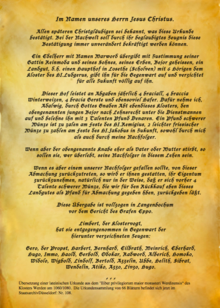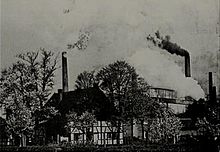Strangemann farm
The Strangemann farm , also known as Strangemannshof , was located in Niederscholven in the current Gelsenkirchen-Scholven district of the city of Gelsenkirchen and was the ancestral home of the Strangemann family .
Settlement history
The Niederolven peasantry was also called “de Loesethe”, “tho Losten” (17th century and earlier) or “Löster Orth” (18th century) in older sources, and like Ober- and Mittelscholven belonged to the Scholver Mark cooperative . The Scholver Mark was a joint property of the farmers and consisted of larger forest and heather areas around Scholven. This mark was the most important institution in the life of the peasantry, because the peasant could not live without wood. The forest had to provide him with the necessary firewood, timber and construction wood, the cattle were grazed on the forest floors and when acorns and beechnuts were ripe, the pigs were driven into the forest and fattened. The Markgenossenschaft developed out of everyone's interest in the use and care of the forest . It was made up of the owners of the farms entitled to use the property; the share of the individual march comrades was determined by the size of the farm and its economic needs.
At the head of the march comrades stood the wood judge Haus Lüttinghof , under his chairman the march comrades met annually. In this timber court , the matters of the mark (use of wood, clearing for the purpose of settlement by kötter, fattening, grazing time, grazing rights) were discussed and the wrongdoers in the forest were punished and recorded in the market protocol. Scherner (market administrator who supervised the market), as well as Schutter / Schütter ("policeman" who confiscated illegally felled wood or foreign cattle and brought them to Lüttinghoff Castle) were appointed by the assembly.
The farms in the Scholver Mark were left to the then servants (farmers) to manage. When hearing medieval peasants are called, which were depending on a landlord. The bondage was passed on to the children. Slaves were unfree and subject to certain restrictions. They could own movable property but not acquire real estate and were tied to land (duty of clods) that belonged to a landowner (nobility or church) who also held jurisdiction over them. They worked the land with the obligation to different taxes and compulsory services to the landlords. In return, the landlord was obliged to protect and care for the serfs.
The land and the unfree peasants who worked it formed an inseparable unit that could not be dissolved, that is, land could not be sold separately by the peasants and vice versa.
In contrast to serfdom , in which the taxes were tied to the person, in the case of serfs they were tied to the farmed property.
The bondage was lifted by the peasant liberation in the 19th century (1848). As a result of this measure, many of the serfs became tenants, but were also able to purchase the land themselves.
As an old settlement in the Mark, the Strangemannshof had 1 farmer's right and 1 pasture right. Compared to the farms, the Kotten only had 2/3 to 5/12 farmer rights. The size of the courtyard was given in the cadastre from 1816 to 1859 as follows: 1816 = 146 acres, 1822 = 190 acres 137 rods 47 feet, 1859 = 247 acres. The Strangemannshof with its subordinate Kotten (W. ob de Straten), was the largest in the peasantry. Due to its size and the closed nature of the land, the farm also had its own hunting rights.
Coordinates: 51 ° 35 ′ 33.4 " N , 7 ° 0 ′ 51.3" E
Manager and owner chronicle
Werden monastery > 1060/80 <landlord of Strangemannshof in LösterOrth
The accompanying document says: The nobleman Marword, with the consent of his wife Reinmoda and his son Bejor, gave his country estate, a main courtyard in Losethe (Gelsenkirchen-Scholven) to the monastery of St. Ludgerus in Werden, for which the abbot Adalwig gave his son Beior among his men and enfeoffed with three pound denarii of annual income.
Translation of the deed of donation no. 1081 from the “Iliber privilegiorum maior monasteri Werdinensis”, a document collection of 66 sheets from the State Archives in Düsseldorf.
Luidbreht de Losethe > 1140-1170 <Manus
Losethd > 1240-1260 <Manus
Hinr. van Losten > 1420 <"Herrnan Wendelen soen"
toe Loesten guet > 1474-1477 <"hevet Bernt Droste"
toe Loesten guet > 1484/85 <"booklet Claes van der Hülsen, Claes sone", tithe levy
Strankman Gert <1502 <"huldich and horig / horich made"
Strantman Johann jr. > 1527 <"Loesten mansus", tithe levy
Stranckmann Gert > 1528 <"Stranckmann is Scherner"
> 1530-1557 <Mentioned in the market protocols for trademark infringement and as Scherner, fellow marrowman
Wessel im Strange > around 1570 <treatment, together with daughter (Gert's heirs)
Treatment = leasing a farm. The treatment can be inherited and also be given into several "hands".
> 1576 <Mitscherner
> 1589/90 < tithe levy
In earlier times it was often written as one speaks, so slight variations in the name were not uncommon, so the names "Stranckmann", "Strantmann" or "im Strange" were mentioned in the sources as "treated". From 1620 the name Strangemann was written as we still write it today. According to the linguistic structure, the name Strangemann is a name form with the ending -mann. Over 5% of German family names contain this suffix, and we meet them in all name groups. The ending “-mann” was often used to form names of origin (Köllmann from Cologne, Neckermann vom Neckar) and as a component of home names (Bachmann, Grundmann) or Strangemann. In the old sources the farm was also called “im Strange to Loesten”, so the Strangemann was the man who lived “im Strange”.
Strangemann Reinhard > 1620-1646 <treatment
> 1646 <treatment, together with son Johann (lease)
Strangemann Johann > 1646 <treatment, together with his father Reinhard
> 1664 <treatment
Strangemann Johan Rüttger > 1675 <treatment, together with his mother
Strangemann Reinhard > 1698 <treatment, together with his mother
> 1708 <Marrowmate
> 1711-1722 <Scherner
> 1716 <treatment with wife instead of mother
> 1726-1740 <Marrowmate
Strangeman Nicl. Rötger > 1760 <treatment
> 1748 <span service
Strangemann Niclas > 1794 <treatment
Strangemann Joh. Heinrich > 1811-1845 <
Strangemann Joh. Heinrich jr. > 1845-1865 <
Strangemann Th. Heinrich > 1866 <entry in the land register.
Brinkmann MC Josefine b. Strangemann > 1880-1904 <
On November 11, 1904, the Strangemannshof became MC from its last owner. Jofine Brinkmann b. Strangemann to the Kgl. Bergfiskus - Hibernia AG sold.
Thus the Strangemannshof was managed by the Strangemann family for 400 years (1502 to 1904) without interruption.
The Strangemannshof buildings were destroyed in the air raids towards the end of World War II and were not rebuilt after the war. A mining settlement was later built in its place.
Furthermore, all persons with the maiden name "Strangemann" can assume that one of his ancestors had a direct connection to the Strangemannshof.
literature
- Gustav A. Spürk: Documentation on the history of the Scholven settlement, part 2. In: Association for local and local history Gelsenkirchen-Buer (Ed.): Contributions to the history of the town. Volume 14. Gelsenkirchen 1996, pp. 224-261.
- Gustav A. Spürk, D. Rohmann: Settlement history documentation Scholven part 4. In: Association for local and local history Gelsenkirchen-Buer (Hrsg.): Contributions to city history. Volume 22. Gelsenkirchen 2000, pp. 171-281.
Web links
Individual evidence
- ^ Contributions to the history of the city, Volume XIX 1996, Association for Local and Local History Gelsenkirchen-Buer “Documentation on the history of the Scholven settlement” Gustav A. Spürk
- ^ Contributions to the history of the city, Volume XXII 2000, Association for Local and Local History Gelsenkirchen-Buer, "Settlement History Documentation Scholven" Spürk and Rohmann
- ↑ Archive Abbey Werden F / I / 253
- ↑ Archive Abbey Werden G / I / 306
- ^ Archive Abbey Werden II 848
- ^ Archive Abbey Werden II / 487
- ↑ Archive Abbey Werden II / 587
- ↑ Stadtarchiv Recklinghausen, inventory: Herzog Arenbergisches Archiv VIII B 242/12
- ^ Archive Abbey Werden II 658
- ↑ a b Market Protocols 1524–1581 Archive: “von Twickel / Havixbeck” Holdings: Lüttinghoff House, File 1034
- ^ Archive Abtei Werden II / 769
- ↑ a b c Market Protocols 1707–1747 State Archives Münster, holdings: Lds.Amt f. Agricultural order file 11200 Spezialia
- ↑ Vest. Service register: 2. Niederscholven



